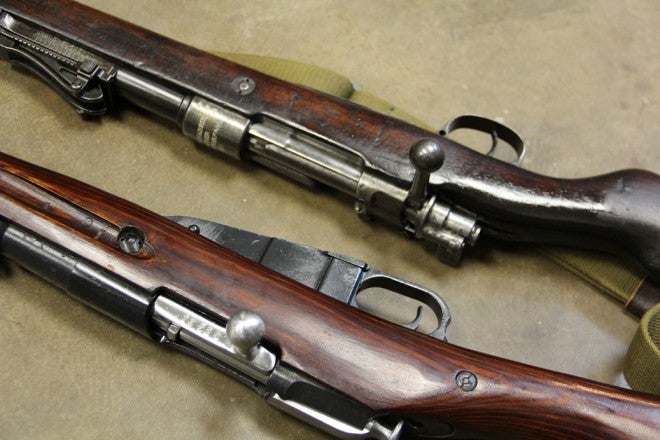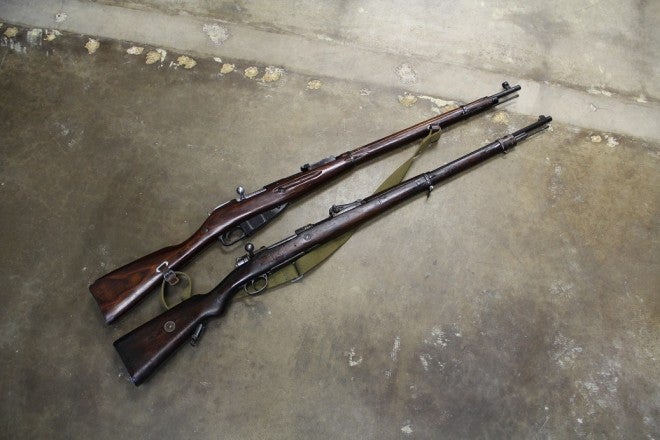A week ago, Alex C. and Miles Vining pitted the Russian Mosin-Nagant against the German Mauser Gewehr 98 in a battle royale shootout to see which was the best rifle. Unsurprising to some, and outrageous to others, Paul Mauser’s masterpiece took home the gold and handily beat the Three Line Rifle, scoring more hits more quickly in all the shooting sessions.
Now, it may seem strange that an avowed Lee-Enfield fan such as myself would take to the keyboard to defend the Mosin-Nagant, especially after such a poor showing in the head-to-head challenge, but I think there are more reasons to take the Russian rifle seriously than just its design and performance. It may be enough for me to say “but the 1891/30 is cheap!” and leave it at that; for some, low-cost is its own reward, and the Mosin-Nagant, though uninspiring as a rifle, is a sound weapon that is unlikely to break or otherwise disappoint, if its known flaws are already accepted by the buyer.
Instead of focusing on its low cost, I’d like to discuss a somewhat roundabout virtue of the Mosin-Nagant that I’ve seen time and time again. The title of this article is a bit odd, but it is a succinct expression of the article’s thesis. I have seen many times academics, geeks, Ph.Ds, doctors, scientists, program managers, software developers, and other intellectual types choose the Mosin-Nagant as their first rifle, and for all its faults, I think this is actually the perfect fit. Why?
The first reason is that Mosins have a lot of history. They are one of the longest-serving bolt-action rifles, and they really light the fire under a creative person’s mind, having served in a long list of wars that well and truly qualifies for “countless”. Setting aside the great battles and wars the Mosin is best known for, A Russian infantryman fighting the Japanese in the 1945 campaign was as likely to have a Mosin as a Vietnamese soldier in Indochina in the late 1950s. Its ubiquity and presence worldwide are what really captures the imaginations of many – I say this having asked several of them – and its crudity is hardly a hindrance in this. Indeed, it may only fuel the fire, as there’s a visceral feeling, almost a connection, holding a meter-long rifle designed in the 19th Century, that has a sticky bolt and a foot and a half long bayonet. The Mosin-Nagant is a rifle that feels like we civilians (perhaps inaccurately) imagine a soldier’s lot to be. Dirty, ugly, uncomfortable, rude, and long. This is surely an over-romanticization, but I’ve seen it at work over and over again. The Mosin-Nagant’s history feels so strongly expressed through its form, design, quirks, and flaws that it has developed a sort of brand loyalty all its own. Mosin-Nagant owners (of which, it should be noted, I am not currently one) are quick to express their allegiance to the rifle, despite the inelegance and ungainliness of the most common variants.
For the cubiclite, though, the rifle offers something else, too. A sort of rude awakening for fingers that put pad to key in endless sequence day after day, lighting off – with a creepy and long trigger pull that builds anticipation and challenges the shooter’s steadiness – a round of 7.62x54R that jars and blasts the air around you and sends the often sharp and rude buttplace hard against the clavicle is enjoyable in its stark contrast. Unlike an M1903, which is, if anything, even more uncomfortable to shoot, the Mosin is honest about itself; its guise is as brutal and uncultivated as the experience of shooting one. It’s not a svelte, restrained gun, but a noisy, uncomfortable weapon of utilitarian and often indifferent war, and it shoots like one. Is it any wonder that Mosin owners often take their rifles hunting, or try to shoot the tightest possible groups with rifles that cost $99.95 plus tax? I think, it is perhaps not about how good the Mosin-Nagant as a rifle is or isn’t, but about the connection between the rifle and the shooter, and about doing your best with modest equipment. True, this may be indulgent in its own way, but I’ve seen it bring shooters back to the shooting bench and the deer blind with their Mosin-Nagants time and time again.
Finally, the Mosin’s experience is fleeting, and I think this is a key ingredient to its popularity among the white collar world. Mosin-Nagants are not a lifestyle; today, and except in the hands of Pashtuns, they are something taken out of the safe and shot from time to time. Their inexpense is a large component of this; for an almost trivial price, a piece of history and a unique (if unsophisticated) shooting experience is within reach. More than one Mosin owner has bought and subsequently forgotten their rifle, the demands of day-to-day life seeming to always get in the way of that range trip they’ve been meaning to take. For many of those, though, the Three-Line rifle was a doorway to the shooting world at large, and I think for that the rifle should always have a place of respect in the shooting community. One Ph.D I know went from shooting his 91/30 at trees in New Hampshire to milling his own 80% AR-15 receivers on his CNC machine, and for others in my personal circle alone, the Mosin-Nagant was the first of numerous milsurp and new firearms that feed their vital shooting habit.
It’s true that the Mosin-Nagant is not the best bolt action rifle in the world. It may be, in a technical sense, one of the worst. Maybe that is its greatest strength for today’s gun buyer, though. While Mausers have all soared in price – despite being made in comparable numbers – the Mosin-Nagant has stayed inexpensive, keeping it within reach of even the most frugal gun buyers. Shooting it is an experience that not only connects the milsurp buyer with the rifle’s history, but Mosin-Nagant owners to each other was well. It is undeniably thrilling to shoot an M44 rifle, bayonet extended, as fast as one can karate chop the bolt handle open, while a friend stands behind and screams to you about impending fascists!
Maybe instead, we should call it the best worst gun ever made.
 Your Privacy Choices
Your Privacy Choices

